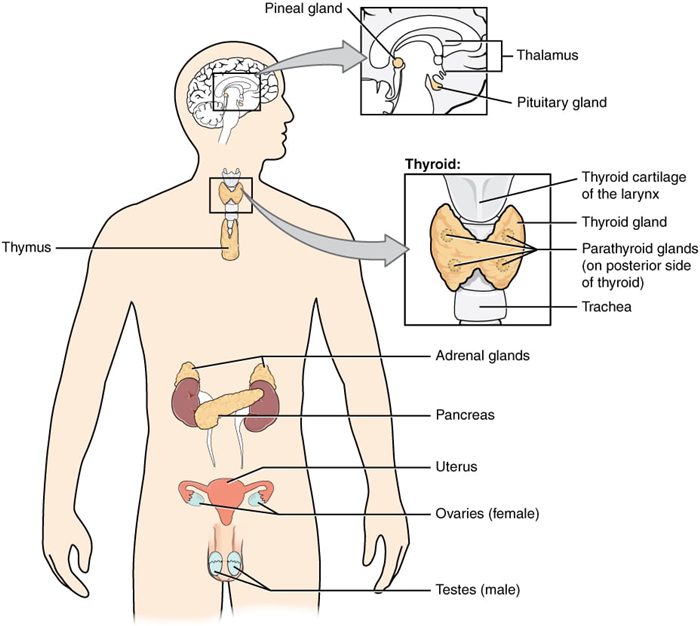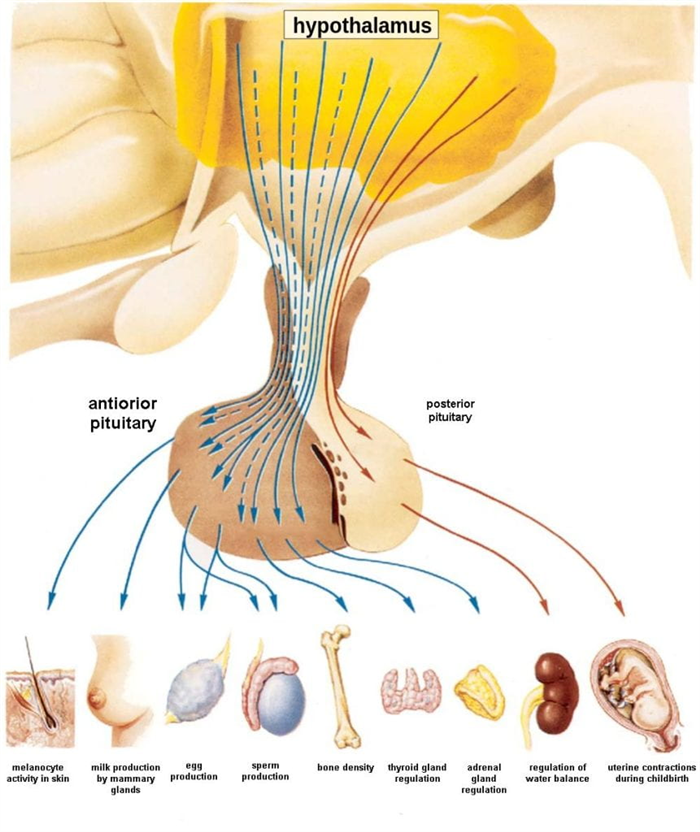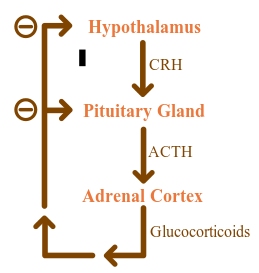Animal Hormones
Unlike plant hormones, animal hormones are often (though not always) produced in specialized hormone-synthesizing glands (shown below). The hormones are then secreted from the glands into the blood stream, where they are transported throughout the body. There are many glands and hormones in different animal species, and we will focus on just a small collection of them.

In vertebrates, glands and hormones they produce include (note that the following list is not complete):
- hypothalamus: located within the brain, the hypothalamus integrates the endocrine and nervous systems; it receives input from the body and other brain areas and initiates endocrine responses to environmental changes, synthesizes hormones which are stored in the posterior pituitary gland, and also synthesizes and secretes regulatory hormones that control the endocrine cells in the anterior pituitary gland
- pituitary gland: the body’s “master gland,” located at the base of the brain and attached to (and regulated by) the hypothalamus
- t he anterior portion of the pituitary gland is regulated by releasing or release-inhibiting hormones produced by the hypothalamus
- the posterior pituitary receives signals via neurosecretory cells to release hormones produced by the hypothalamus
- the adrenal cortex produces mineralocorticoids, such as aldosterone, which increases reabsorption of sodium by kidneys to regulate water balance; and glucocorticoids, such as cortisol, which is a long-term stress response hormones that increase blood glucose levels by stimulating synthesis of glucose and gluconeogenesis (converting a non-carbohydrate to glucose) by liver cells; promote the release of fatty acids from adipose tissue
- the adrenal medulla produces epinephrine (adrenaline) a short-term stress response (“fight-or-flight”) hormone that increases heart rate, breathing rate, cardiac muscle contractions, blood pressure, and blood glucose levels; accelerates the breakdown of glucose in skeletal muscles and stored fats in adipose tissue; the release of epinephrine is stimulated directly by neural impulses from the sympathetic nervous system
The processes and organs regulated by the pituitary gland are summarized here:

This video provides a nice overview of the glands and hormones of the vertebrate endocrine system:

Uncontrolled blood glucose levels can lead to different types of serious medical conditions:
- Impaired insulin function can lead to a condition called diabetes mellitus. Diabetes mellitus can be caused by low levels of insulin production by the beta cells of the pancreas, or by reduced sensitivity of tissue cells to insulin. Either of these situations prevents glucose from being absorbed by cells, causing high levels of blood glucose, or hyperglycemia (high sugar). Over time, high blood glucose levels can cause nerve damage to the eyes and peripheral body tissues, as well as damage to the kidneys and cardiovascular system.
- Oversecretion of insulin can cause hypoglycemia, low blood glucose levels, which causes insufficient glucose availability to cells, often leading to muscle weakness, and can sometimes cause unconsciousness or death if left untreated.
This animation describes diabetes and the roles of insulin and the pancreas in blood glucose regulation:

In contrast to chronic long-term stress, the video below discusses some of the circumstances where stress can be good for you: